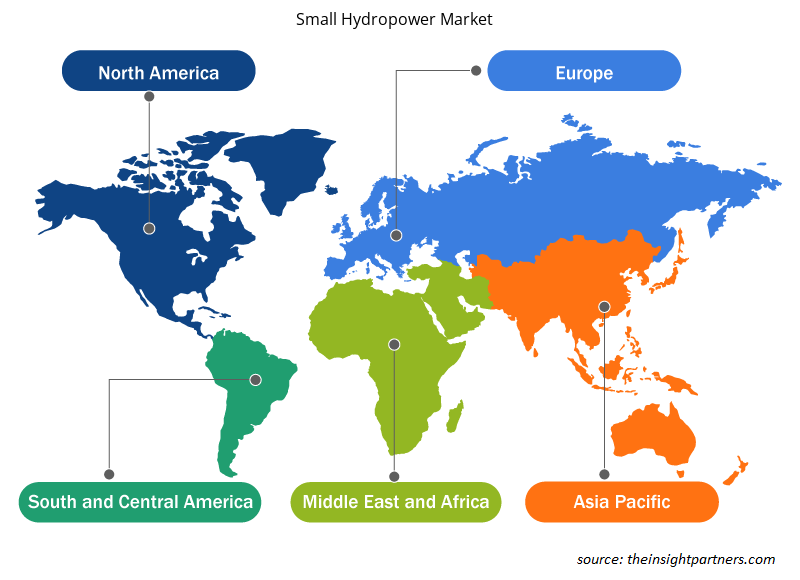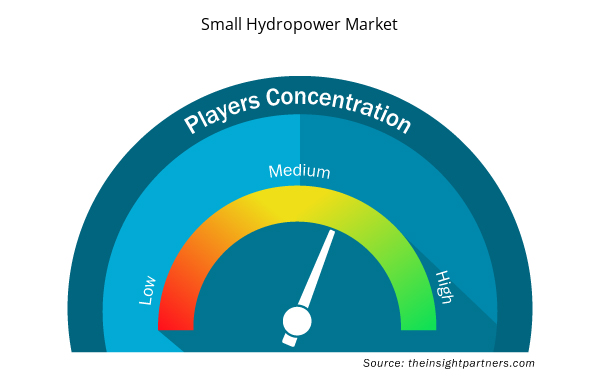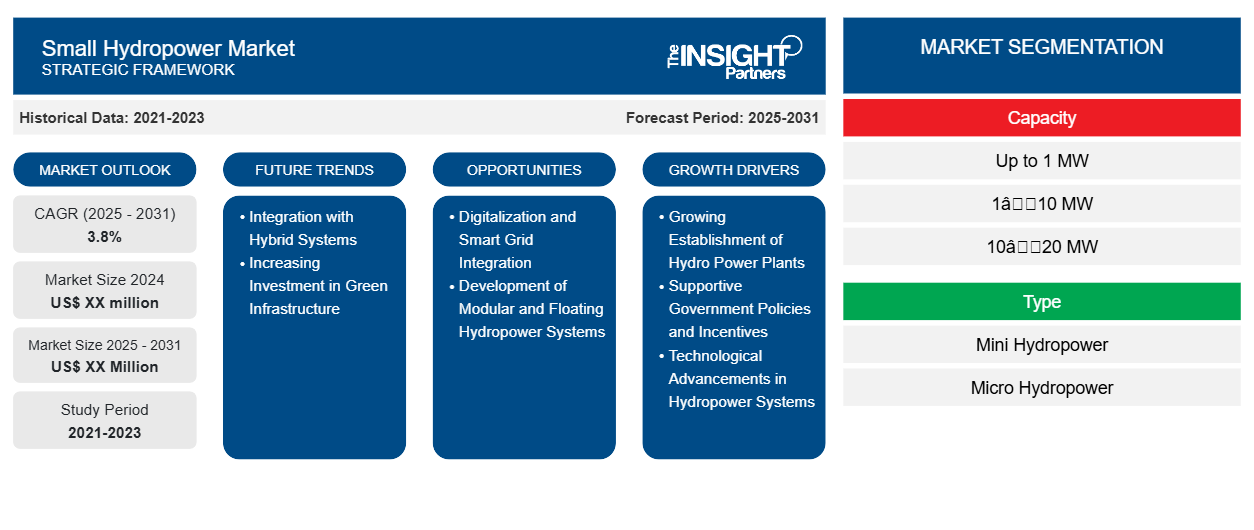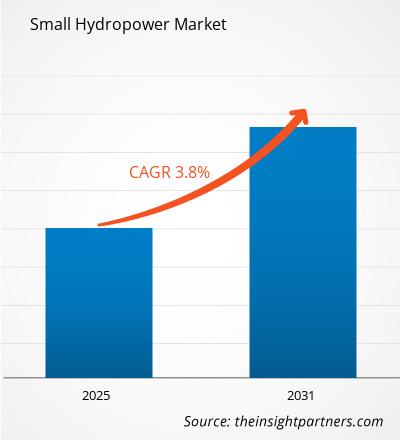Es wird erwartet, dass der Markt für Kleinwasserkraft von 2024 bis 2031 eine durchschnittliche jährliche Wachstumsrate (CAGR) von 3,8 % verzeichnet und dass die Marktgröße von XX Millionen US-Dollar im Jahr 2024 auf XX Millionen US-Dollar im Jahr 2031 anwächst.
Der Bericht ist nach Kapazität segmentiert (bis zu 1 MW, 1–10 MW, 10–20 MW, 20–30 MW). Der Bericht enthält außerdem eine Analyse basierend auf dem Typ (Mini-Wasserkraft, Mikro-Wasserkraft). Der Bericht enthält außerdem eine Analyse basierend auf der Konfiguration (Laufwasserkraftwerk, Speicherwasser). Die globale Analyse ist weiter auf regionaler Ebene und nach wichtigen Ländern aufgeschlüsselt. Der Bericht bietet den Wert in USD für die oben genannte Analyse und die Segmente.
Zweck des Berichts
Der Bericht „Small Hydropower Market“ von The Insight Partners soll die aktuelle Landschaft und das zukünftige Wachstum sowie die wichtigsten Antriebsfaktoren, Herausforderungen und Chancen beschreiben. Dies wird verschiedenen Geschäftspartnern Einblicke geben, wie zum Beispiel:
- Technologieanbieter/-hersteller: Um die sich entwickelnde Marktdynamik zu verstehen und die potenziellen Wachstumschancen zu kennen, damit sie fundierte strategische Entscheidungen treffen können.
- Investoren: Durchführung einer umfassenden Trendanalyse hinsichtlich der Marktwachstumsrate, der finanziellen Marktprognosen und der Chancen entlang der Wertschöpfungskette.
- Regulierungsbehörden: Zur Regulierung von Richtlinien und Überwachungsaktivitäten auf dem Markt mit dem Ziel, Missbrauch zu minimieren, das Vertrauen der Anleger zu bewahren und die Integrität und Stabilität des Marktes aufrechtzuerhalten.
Marktsegmentierung für Kleinwasserkraft
Kapazität
- Bis zu 1 MW
- 1-10 MW
- 10-20 MW
- 20-30 MW
Typ
- Mini-Wasserkraft
- Mikro-Wasserkraft
Konfiguration
- Laufwasser
- Speicherwasser
Geographie
- Nordamerika
- Europa
- Asien-Pazifik
- Süd- und Mittelamerika
- Naher Osten und Afrika
Passen Sie diesen Bericht Ihren Anforderungen an
Sie erhalten kostenlos individuelle Anpassungen an jedem Bericht, einschließlich Teilen dieses Berichts oder einer Analyse auf Länderebene, eines Excel-Datenpakets sowie tolle Angebote und Rabatte für Start-ups und Universitäten.
- Holen Sie sich die wichtigsten Markttrends aus diesem Bericht.Dieses KOSTENLOSE Beispiel umfasst eine Datenanalyse von Markttrends bis hin zu Schätzungen und Prognosen.
Wachstumstreiber auf dem Markt für Kleinwasserkraft
- Zunehmende Errichtung von Wasserkraftwerken: Das weltweite Wachstum des Energiebedarfs, das durch Bevölkerungswachstum und Industrialisierung angetrieben wird, erfordert eine Ausweitung der Energieproduktion, was wiederum das Wachstum des Marktes für Wasserkrafterzeugung ankurbeln dürfte. Wasserkraft kann einen erheblichen Teil des zur Deckung dieses Bedarfs benötigten Stroms liefern und so zu einer zuverlässigen Energieversorgung beitragen. Darüber hinaus ist die Energiesicherheit ein grundlegender Faktor für die weltweite Ausweitung der Wasserkraft. Die Nationen suchen nach vielfältigen und zuverlässigen Energiequellen, um ihre Abhängigkeit von fossilen Brennstoffen zu verringern und eine stabile Energieversorgung für Wirtschaftswachstum und nationale Sicherheit zu gewährleisten. Ein solcher Anstieg der Errichtung von Wasserkraftwerken dürfte den Markt für Kleinwasserkraft in den kommenden Jahren ankurbeln.
- Unterstützende staatliche Maßnahmen und Anreize: Weltweit ermutigen günstige Maßnahmen und Anreize der Regierungen dazu, auf erneuerbare Energiequellen wie Kleinwasserkraft umzusteigen. Tatsächlich reicht dies von der Gewährung von Subventionen und Steuererleichterungen bis hin zu direkten Zuschüssen, einschließlich zinsgünstiger Darlehen. In mehreren Fällen werden von den jeweiligen Regierungen verschiedene Einspeisetarife (FITs) und Stromabnahmeverträge angeboten, sodass der Strom aus diesen Kleinwasserkraftwerken seinen Verkaufspreis für die jeweiligen Netze über lange Zeiträume garantiert. Günstige Maßnahmen und Anreize fördern das Wachstum des Kleinwasserkraftmarktes.
- Technologische Fortschritte bei Wasserkraftsystemen: Fortschritte in der Wasserkrafttechnologie, insbesondere bei Turbinenkonstruktion und -effizienz, machen kleinere Wasserkraftsysteme attraktiv und kostengünstig. Technologien in Niederdruckturbinen, Mikrowasserkraftsystemen und modularen Wasserkraftdesigns tragen zur Entwicklung effizienterer und flexiblerer Wasserkraftwerke bei. Solche Systeme können problemlos in Flüssen, Bächen und Kanälen installiert werden, ohne das lokale Ökosystem zu beeinträchtigen. Dadurch wird die Kleinwasserkraft in Regionen, in denen herkömmliche Wasserkraft im großen Maßstab nicht eingesetzt werden kann, zunehmend rentabel. Darüber hinaus stärken weitere Verbesserungen bei der technologischen Innovation in den Bereichen Energiespeicherung und Smart Grid-Integration die Rolle der Kleinwasserkraft in lokalen Energiesystemen.
Zukünftige Trends auf dem Markt für Kleinwasserkraft
- Integration in Hybridsysteme: Kleine Wasserkraftanlagen können in Hybridenergiesysteme integriert werden, die verschiedene erneuerbare Energiequellen wie Sonne, Wind und Biomasse mit Energiespeicherlösungen kombinieren. Hybridsysteme ermöglichen eine zuverlässigere und gleichmäßigere Stromversorgung, da sie die Schwankungen bei Sonnen- und Windenergie durch die kontinuierliche Erzeugungskapazität kleiner Wasserkraftanlagen ausgleichen. Diese Integration verspricht viel, da sie kleine Wasserkraftwerke effizienter und zuverlässiger machen könnte, sodass sie sich gut für vernetzte und nicht vernetzte Anwendungen eignen.
- Steigende Investitionen in grüne Infrastruktur: Mit dem weltweiten Vorstoß hin zu einer nachhaltigen Infrastrukturentwicklung erfreuen sich Investitionen in grüne Technologien, darunter auch Kleinwasserkraft, zunehmender Beliebtheit. Regierungen und private Investoren erkennen die Bedeutung der Umstellung auf nachhaltige, umweltfreundliche Energiesysteme und entdecken Kleinwasserkraft daher zunehmend als tragfähige, umweltschonende Energiequelle. Dieser Trend stellt daher eine große Chance für den Markt dar, da Kleinwasserkraftprojekte das übergeordnete Ziel einer kohlenstoffarmen Wirtschaft unterstützen und zudem zur Schaffung von Arbeitsplätzen und zur lokalen Wirtschaftsentwicklung beitragen.hydropower, are becoming increasingly popular. Governments and private investors realize the significance of shifting toward sustainable, environmentally friendly energy systems and, therefore, are gradually finding small hydropower as a viable, low-impact energy source. This trend therefore represents a significant opportunity for the market, because small hydropower projects support the larger goal of attaining a low-carbon economy and also help to spur job creation and local economic development.
Marktchancen für KleinwasserkraftHydropower Market Opportunities
- Digitalisierung und Smart Grid-Integration: Das zukünftige Wachstum des Marktes für Kleinwasserkraft wird entscheidend von der Integration von Smart Grid-Technologien und der Digitalisierung abhängen. Smart Grids ermöglichen eine effektivere und flexiblere Verwaltung der Stromerzeugung, -speicherung und -verteilung. Fernüberwachung und Datenanalyse können die Leistung der Betreiber optimieren, die Wartungskosten senken und die Zuverlässigkeit erhöhen. Dieser Trend zu mehr Automatisierung und Steuerung wird die zukünftige Entwicklung von Kleinwasserkraftsystemen in Richtung Effizienz, Zuverlässigkeit und Flexibilität vorantreiben. and Smart Grid Integration: Future growth of the small hydropower market will depend crucially on the integration of smart grid technologies and digitalization. Smart grids allow for more effective management of power generation, storage, and distribution in a more efficient and flexible manner. Remote monitoring and data analytics can optimize the performance of operators, cut maintenance costs, and make it more reliable. This trend toward greater automation and control will drive future development in small hydropower systems toward efficiency, reliability, and flexibility.
- Entwicklung modularer und schwimmender Wasserkraftsysteme: Ein weiterer spannender Trend ist die Entwicklung modularer und schwimmender kleiner Wasserkraftsysteme. Schwimmende Wasserkraftsysteme werden für den Betrieb auf Seen, Stauseen und Kanälen konstruiert und sind eine einzigartige Lösung, wenn die Installation traditioneller landgestützter Anlagen unmöglich wird. Systeme können schnell vergrößert oder verkleinert werden; daher können sie auf unterschiedliche, kleine, aber oft notwendige Energiebedürfnisse reagieren. Modulare Designs ermöglichen außerdem eine kostengünstige und schnellere Bereitstellung, was sie zu einer großartigen Wahl für abgelegene Gebiete und kleinere Gemeinden macht.Hydropower Systems: Another exciting trend is that of the development of modular and floating small hydropower systems. Floating hydropower systems are constructed to run on lakes, reservoirs, and canals as unique solutions where installing traditional land-based facilities becomes impossible. Systems can be quickly scaled up or down; therefore, they can respond to varying degrees of small, but often necessary energy needs. Modular designs also enable inexpensive and quicker deployment, which makes them a great choice for remote areas and smaller communities.
Regionale Einblicke in den Markt für KleinwasserkraftHydropower Market Regional Insights
Die regionalen Trends und Faktoren, die den Markt für Kleinwasserkraft im Prognosezeitraum beeinflussen, wurden von den Analysten von Insight Partners ausführlich erläutert. In diesem Abschnitt werden auch die Marktsegmente und die Geografie von Kleinwasserkraft in Nordamerika, Europa, im asiatisch-pazifischen Raum, im Nahen Osten und Afrika sowie in Süd- und Mittelamerika erörtert.Hydropower Market throughout the forecast period have been thoroughly explained by the analysts at Insight Partners. This section also discusses Small Hydropower Market segments and geography across North America, Europe, Asia Pacific, Middle East and Africa, and South and Central America.

- Erhalten Sie regionale Daten zum Markt für Kleinwasserkraft
Umfang des Marktberichts über Kleinwasserkraft
| Berichtsattribut | Details |
|---|---|
| Marktgröße im Jahr 2024 | XX Millionen US-Dollar |
| Marktgröße bis 2031 | XX Millionen US-Dollar |
| Globale CAGR (2025 - 2031) | 3,8 % |
| Historische Daten | 2021-2023 |
| Prognosezeitraum | 2025–2031 |
| Abgedeckte Segmente | Nach Kapazität
|
| Abgedeckte Regionen und Länder | Nordamerika
|
| Marktführer und wichtige Unternehmensprofile |
|
Marktdichte von Kleinwasserkraftwerken: Auswirkungen auf die Geschäftsdynamik verstehen
Der Markt für Kleinwasserkraft wächst rasant, angetrieben durch die steigende Endverbrauchernachfrage aufgrund von Faktoren wie sich entwickelnden Verbraucherpräferenzen, technologischen Fortschritten und einem größeren Bewusstsein für die Vorteile des Produkts. Mit steigender Nachfrage erweitern Unternehmen ihr Angebot, entwickeln Innovationen, um die Bedürfnisse der Verbraucher zu erfüllen, und nutzen neue Trends, was das Marktwachstum weiter ankurbelt.
Die Marktteilnehmerdichte bezieht sich auf die Verteilung der Firmen oder Unternehmen, die in einem bestimmten Markt oder einer bestimmten Branche tätig sind. Sie gibt an, wie viele Wettbewerber (Marktteilnehmer) in einem bestimmten Marktraum im Verhältnis zu seiner Größe oder seinem gesamten Marktwert präsent sind.
Die wichtigsten auf dem Markt für Kleinwasserkraft tätigen Unternehmen sind:
- ANDRITZ AG
- B fouress (P) Ltd
- Allgemeine Elektrizit?tsgesellschaft
- Gilbert Gilkes und Gordon Ltd
- Greenbug Energy Inc.
Haftungsausschluss : Die oben aufgeführten Unternehmen sind nicht in einer bestimmten Reihenfolge aufgeführt.

- Überblick über die wichtigsten Akteure auf dem Markt für Kleinwasserkraft
Wichtige Verkaufsargumente
- Umfassende Abdeckung: Der Bericht deckt die Analyse der Produkte, Dienstleistungen, Typen und Endnutzer des Marktes für Kleinwasserkraft umfassend ab und bietet einen ganzheitlichen Überblick.
- Expertenanalyse: Der Bericht basiert auf dem umfassenden Verständnis von Branchenexperten und Analysten.
- Aktuelle Informationen: Der Bericht stellt durch die Abdeckung aktueller Informationen und Datentrends Geschäftsrelevanz sicher.
- Anpassungsoptionen: Dieser Bericht kann angepasst werden, um spezifische Kundenanforderungen zu erfüllen und die Geschäftsstrategien optimal anzupassen.
Der Forschungsbericht zum Markt für Kleinwasserkraft kann daher dabei helfen, die Branchensituation und Wachstumsaussichten zu entschlüsseln und zu verstehen. Obwohl es einige berechtigte Bedenken geben kann, überwiegen die allgemeinen Vorteile dieses Berichts tendenziell die Nachteile.
- Historische Analyse (2 Jahre), Basisjahr, Prognose (7 Jahre) mit CAGR
- PEST- und SWOT-Analyse
- Marktgröße Wert/Volumen – Global, Regional, Land
- Branche und Wettbewerbsumfeld
- Excel-Datensatz



Report Coverage
Revenue forecast, Company Analysis, Industry landscape, Growth factors, and Trends

Segment Covered
This text is related
to segments covered.

Regional Scope
North America, Europe, Asia Pacific, Middle East & Africa, South & Central America

Country Scope
This text is related
to country scope.
Häufig gestellte Fragen
Some of the customization options available based on the request are an additional 3-5 company profiles and country-specific analysis of 3-5 countries of your choice. Customizations are to be requested/discussed before making final order confirmation, as our team would review the same and check the feasibility.
The report can be delivered in PDF/PPT format; we can also share excel dataset based on the request.
The leading players operating in the Small Hydropower Market include ANDRITZ AG, Hitachi Mitsubishi Hydro Corporation, GENERAL ELECTRIC, Natel Energy, Siemens Energy, Voith GmbH and Co. KGaA, Toshiba Energy Systems and Solutions Corporation, Canadian Hydro Components Ltd., Bharat Heavy Electricals Limited, and Canyon Hydro
Integration with Hybrid Systems is the key future trend of the Small Hydropower Market
The Small Hydropower Market is estimated to witness a CAGR of 3.8% from 2023 to 2031
The major factors driving the Small Hydropower Market are: Growing Establishment of Hydro Power Plants and Supportive Government Policies and Incentives
Trends and growth analysis reports related to Energy and Power : READ MORE..
1. ANDRITZ AG
2. B fouress(P) Ltd
3. General Electric Company
4. Gilbert Gilkes and Gordon Ltd
5. Greenbug Energy Inc.
6. Kolektor Turboinštitut d.o.o.
7. Siemens AG
8. SNC-Lavalin Group
9. Toshiba Energy Systems and Solutions Corporation
10. Voith GmbH and Co. KGaA
The Insight Partners performs research in 4 major stages: Data Collection & Secondary Research, Primary Research, Data Analysis and Data Triangulation & Final Review.
- Data Collection and Secondary Research:
As a market research and consulting firm operating from a decade, we have published and advised several client across the globe. First step for any study will start with an assessment of currently available data and insights from existing reports. Further, historical and current market information is collected from Investor Presentations, Annual Reports, SEC Filings, etc., and other information related to company’s performance and market positioning are gathered from Paid Databases (Factiva, Hoovers, and Reuters) and various other publications available in public domain.
Several associations trade associates, technical forums, institutes, societies and organization are accessed to gain technical as well as market related insights through their publications such as research papers, blogs and press releases related to the studies are referred to get cues about the market. Further, white papers, journals, magazines, and other news articles published in last 3 years are scrutinized and analyzed to understand the current market trends.
- Primary Research:
The primarily interview analysis comprise of data obtained from industry participants interview and answers to survey questions gathered by in-house primary team.
For primary research, interviews are conducted with industry experts/CEOs/Marketing Managers/VPs/Subject Matter Experts from both demand and supply side to get a 360-degree view of the market. The primary team conducts several interviews based on the complexity of the markets to understand the various market trends and dynamics which makes research more credible and precise.
A typical research interview fulfils the following functions:
- Provides first-hand information on the market size, market trends, growth trends, competitive landscape, and outlook
- Validates and strengthens in-house secondary research findings
- Develops the analysis team’s expertise and market understanding
Primary research involves email interactions and telephone interviews for each market, category, segment, and sub-segment across geographies. The participants who typically take part in such a process include, but are not limited to:
- Industry participants: VPs, business development managers, market intelligence managers and national sales managers
- Outside experts: Valuation experts, research analysts and key opinion leaders specializing in the electronics and semiconductor industry.
Below is the breakup of our primary respondents by company, designation, and region:

Once we receive the confirmation from primary research sources or primary respondents, we finalize the base year market estimation and forecast the data as per the macroeconomic and microeconomic factors assessed during data collection.
- Data Analysis:
Once data is validated through both secondary as well as primary respondents, we finalize the market estimations by hypothesis formulation and factor analysis at regional and country level.
- Macro-Economic Factor Analysis:
We analyse macroeconomic indicators such the gross domestic product (GDP), increase in the demand for goods and services across industries, technological advancement, regional economic growth, governmental policies, the influence of COVID-19, PEST analysis, and other aspects. This analysis aids in setting benchmarks for various nations/regions and approximating market splits. Additionally, the general trend of the aforementioned components aid in determining the market's development possibilities.
- Country Level Data:
Various factors that are especially aligned to the country are taken into account to determine the market size for a certain area and country, including the presence of vendors, such as headquarters and offices, the country's GDP, demand patterns, and industry growth. To comprehend the market dynamics for the nation, a number of growth variables, inhibitors, application areas, and current market trends are researched. The aforementioned elements aid in determining the country's overall market's growth potential.
- Company Profile:
The “Table of Contents” is formulated by listing and analyzing more than 25 - 30 companies operating in the market ecosystem across geographies. However, we profile only 10 companies as a standard practice in our syndicate reports. These 10 companies comprise leading, emerging, and regional players. Nonetheless, our analysis is not restricted to the 10 listed companies, we also analyze other companies present in the market to develop a holistic view and understand the prevailing trends. The “Company Profiles” section in the report covers key facts, business description, products & services, financial information, SWOT analysis, and key developments. The financial information presented is extracted from the annual reports and official documents of the publicly listed companies. Upon collecting the information for the sections of respective companies, we verify them via various primary sources and then compile the data in respective company profiles. The company level information helps us in deriving the base number as well as in forecasting the market size.
- Developing Base Number:
Aggregation of sales statistics (2020-2022) and macro-economic factor, and other secondary and primary research insights are utilized to arrive at base number and related market shares for 2022. The data gaps are identified in this step and relevant market data is analyzed, collected from paid primary interviews or databases. On finalizing the base year market size, forecasts are developed on the basis of macro-economic, industry and market growth factors and company level analysis.
- Data Triangulation and Final Review:
The market findings and base year market size calculations are validated from supply as well as demand side. Demand side validations are based on macro-economic factor analysis and benchmarks for respective regions and countries. In case of supply side validations, revenues of major companies are estimated (in case not available) based on industry benchmark, approximate number of employees, product portfolio, and primary interviews revenues are gathered. Further revenue from target product/service segment is assessed to avoid overshooting of market statistics. In case of heavy deviations between supply and demand side values, all thes steps are repeated to achieve synchronization.
We follow an iterative model, wherein we share our research findings with Subject Matter Experts (SME’s) and Key Opinion Leaders (KOLs) until consensus view of the market is not formulated – this model negates any drastic deviation in the opinions of experts. Only validated and universally acceptable research findings are quoted in our reports.
We have important check points that we use to validate our research findings – which we call – data triangulation, where we validate the information, we generate from secondary sources with primary interviews and then we re-validate with our internal data bases and Subject matter experts. This comprehensive model enables us to deliver high quality, reliable data in shortest possible time.


 Holen Sie sich ein kostenloses Muster für diesen Bericht
Holen Sie sich ein kostenloses Muster für diesen Bericht